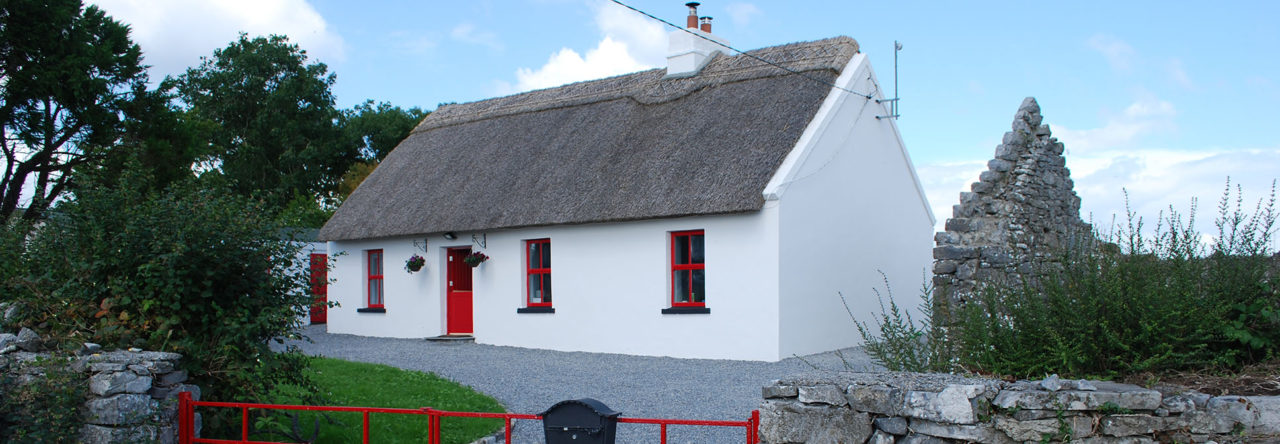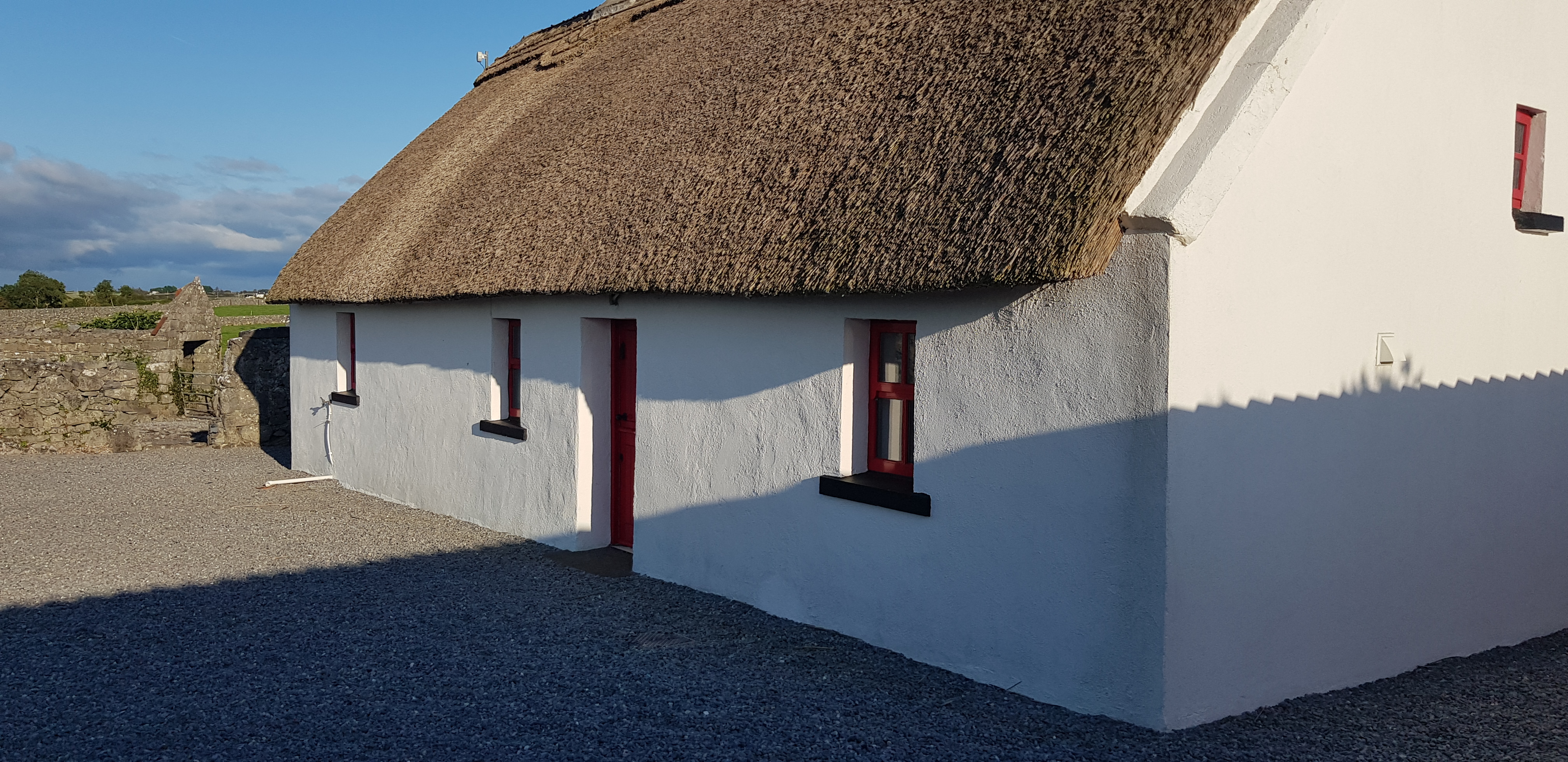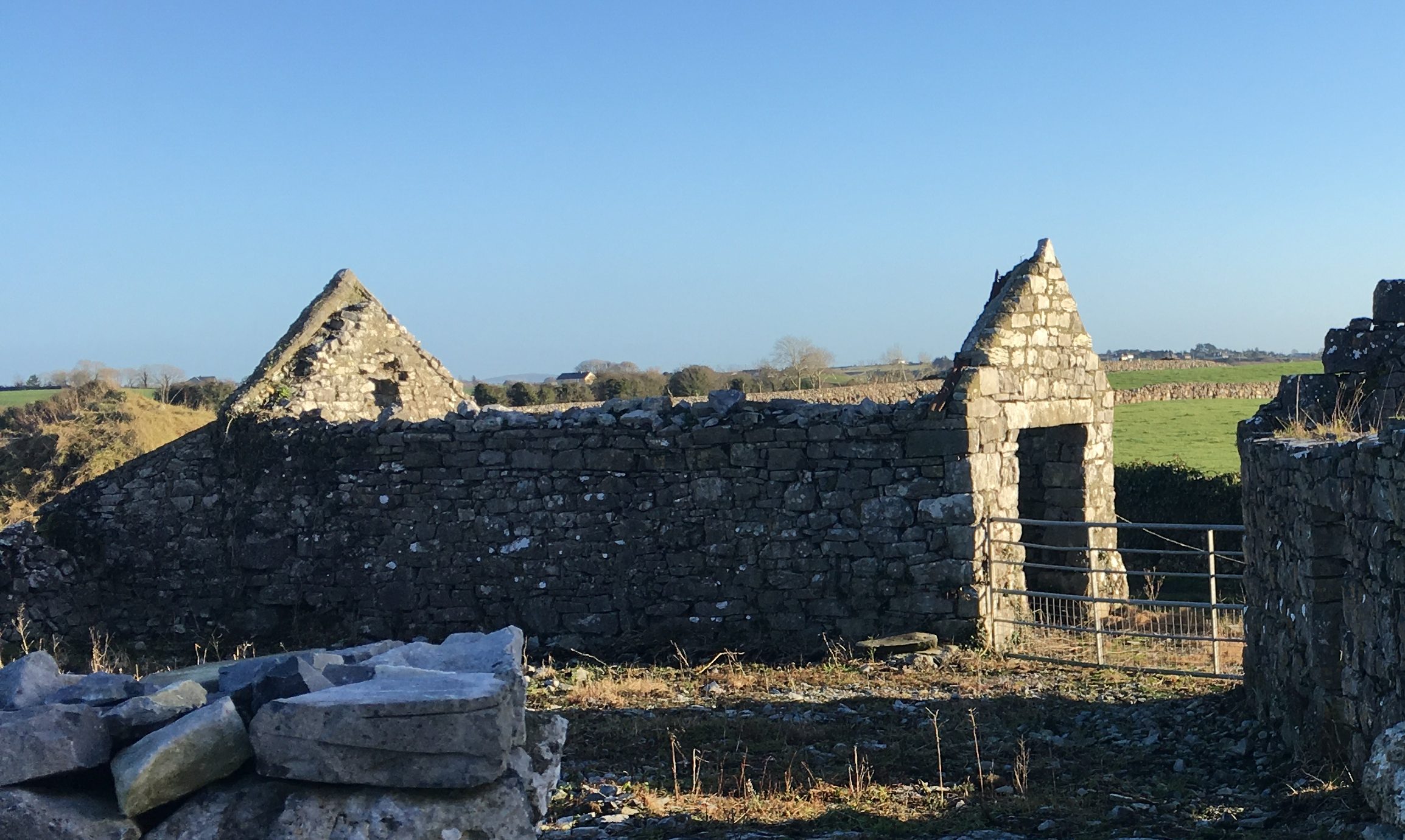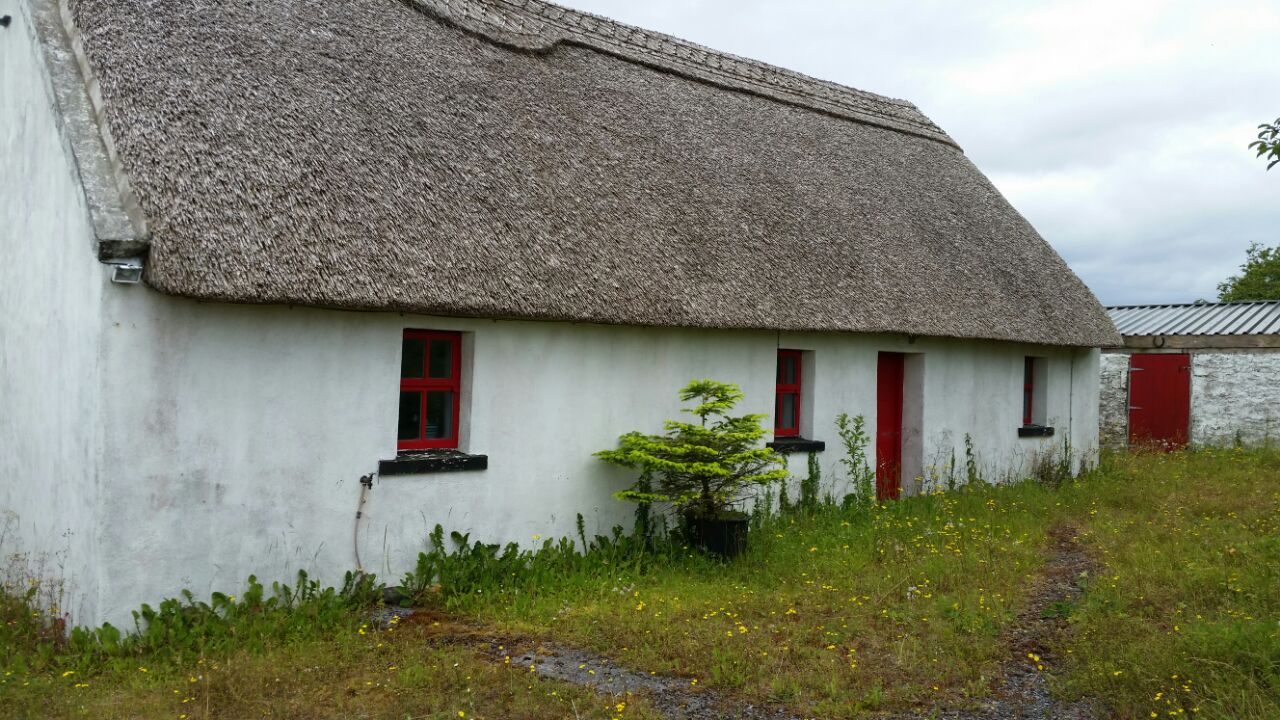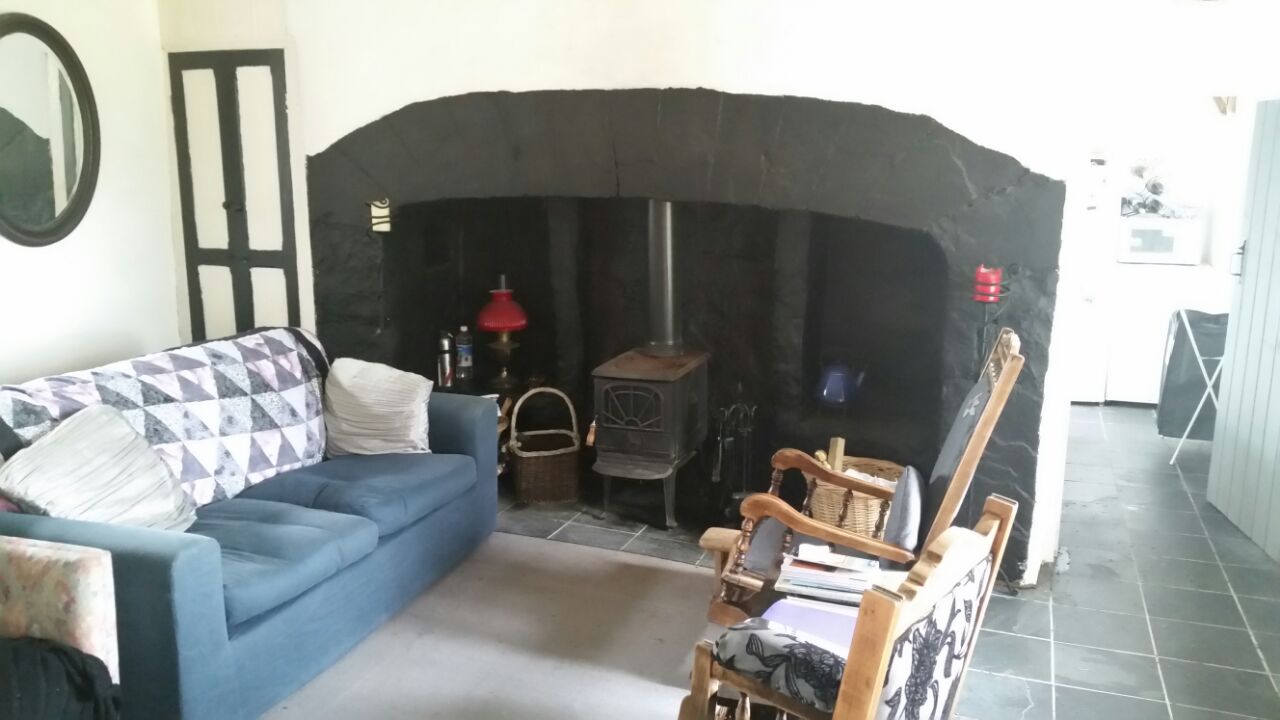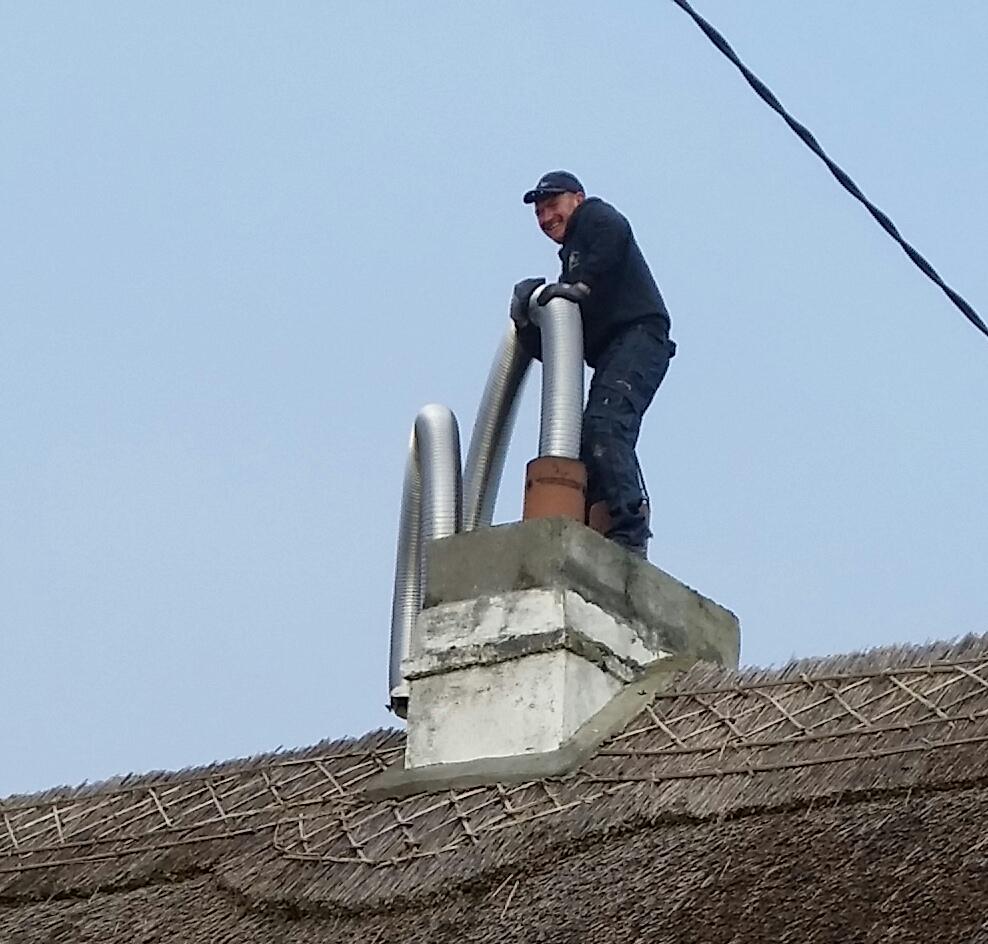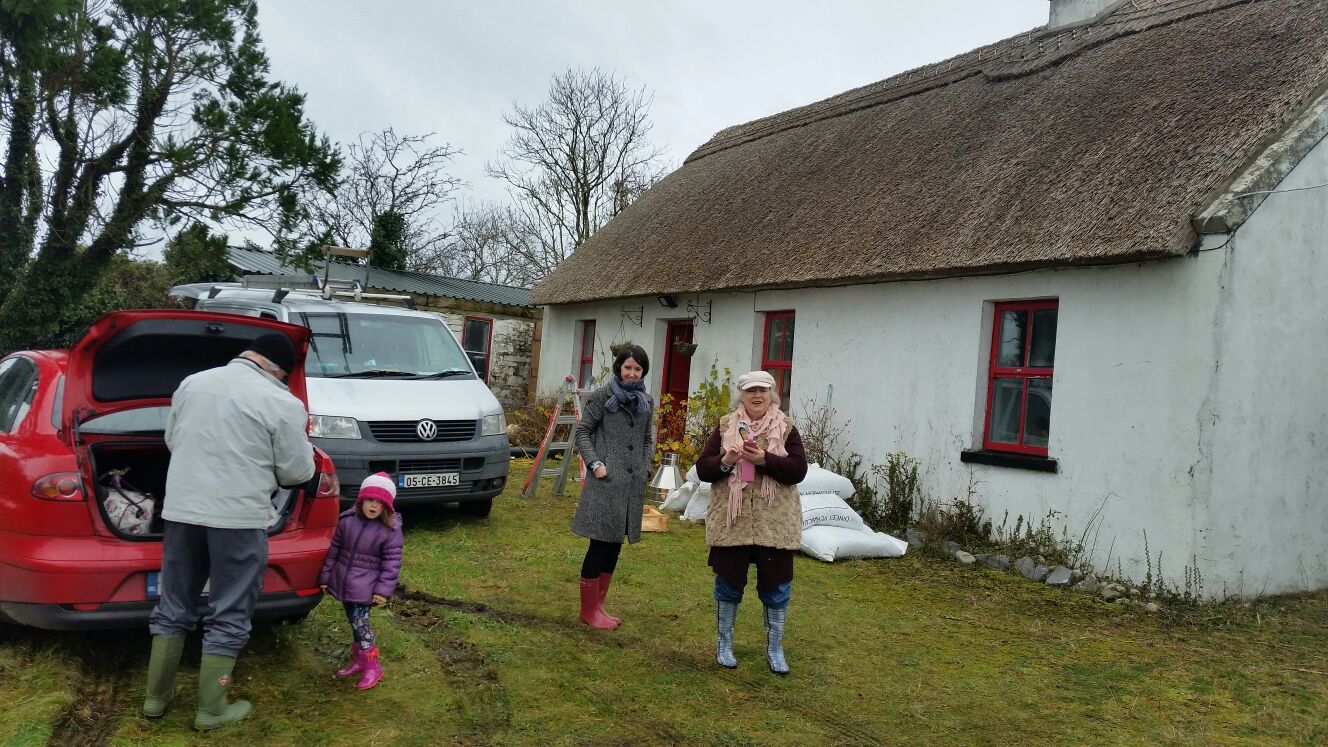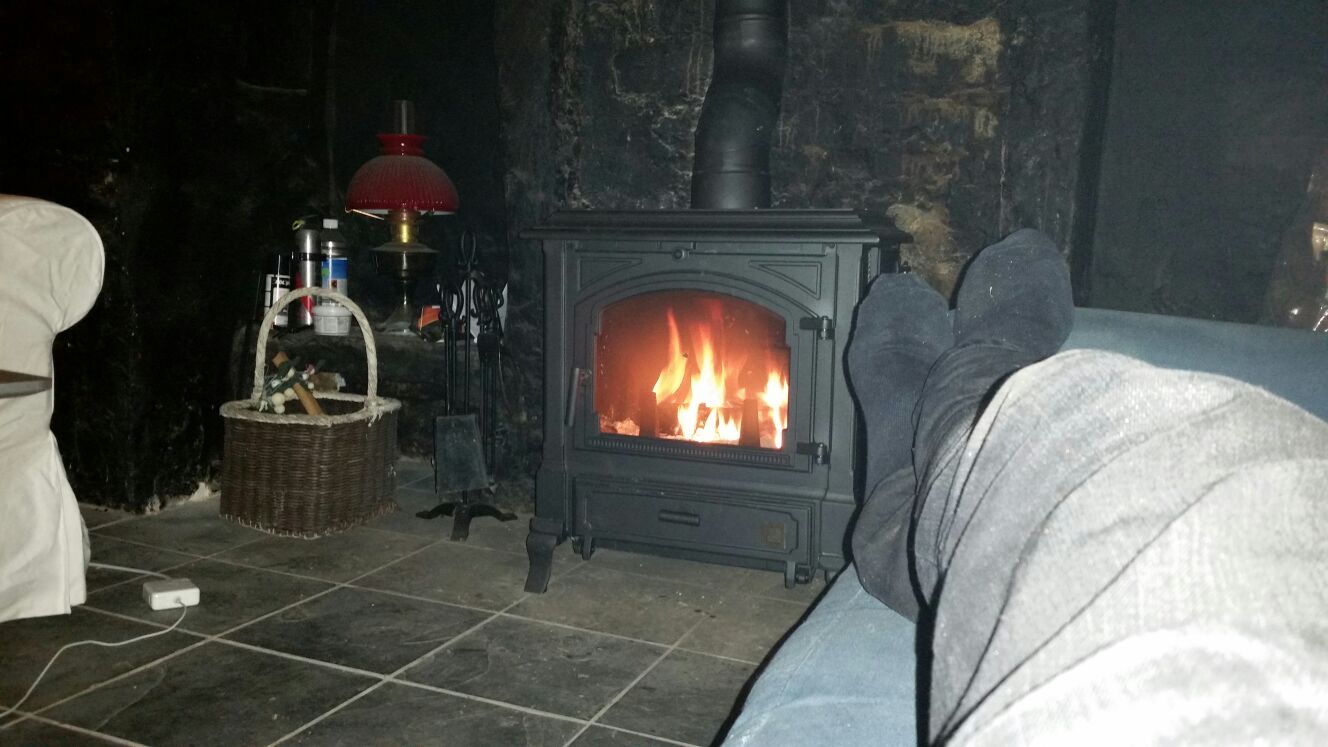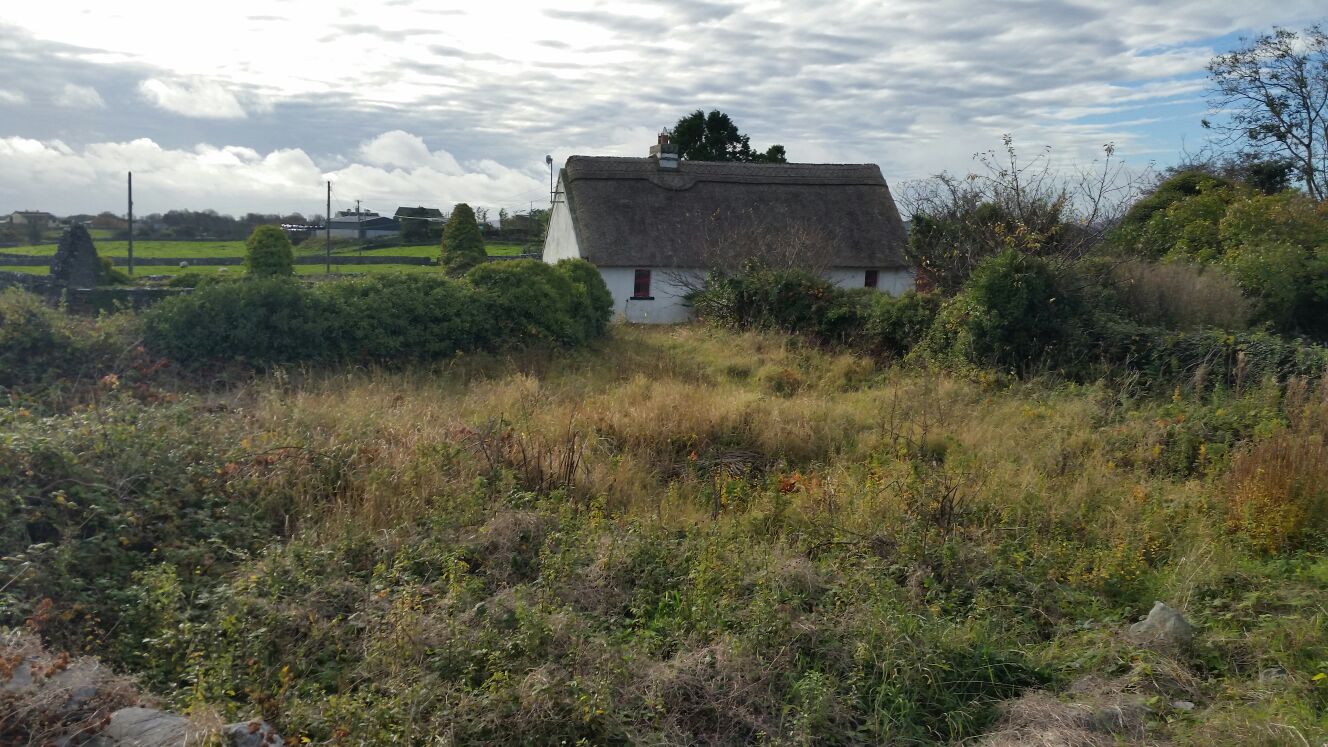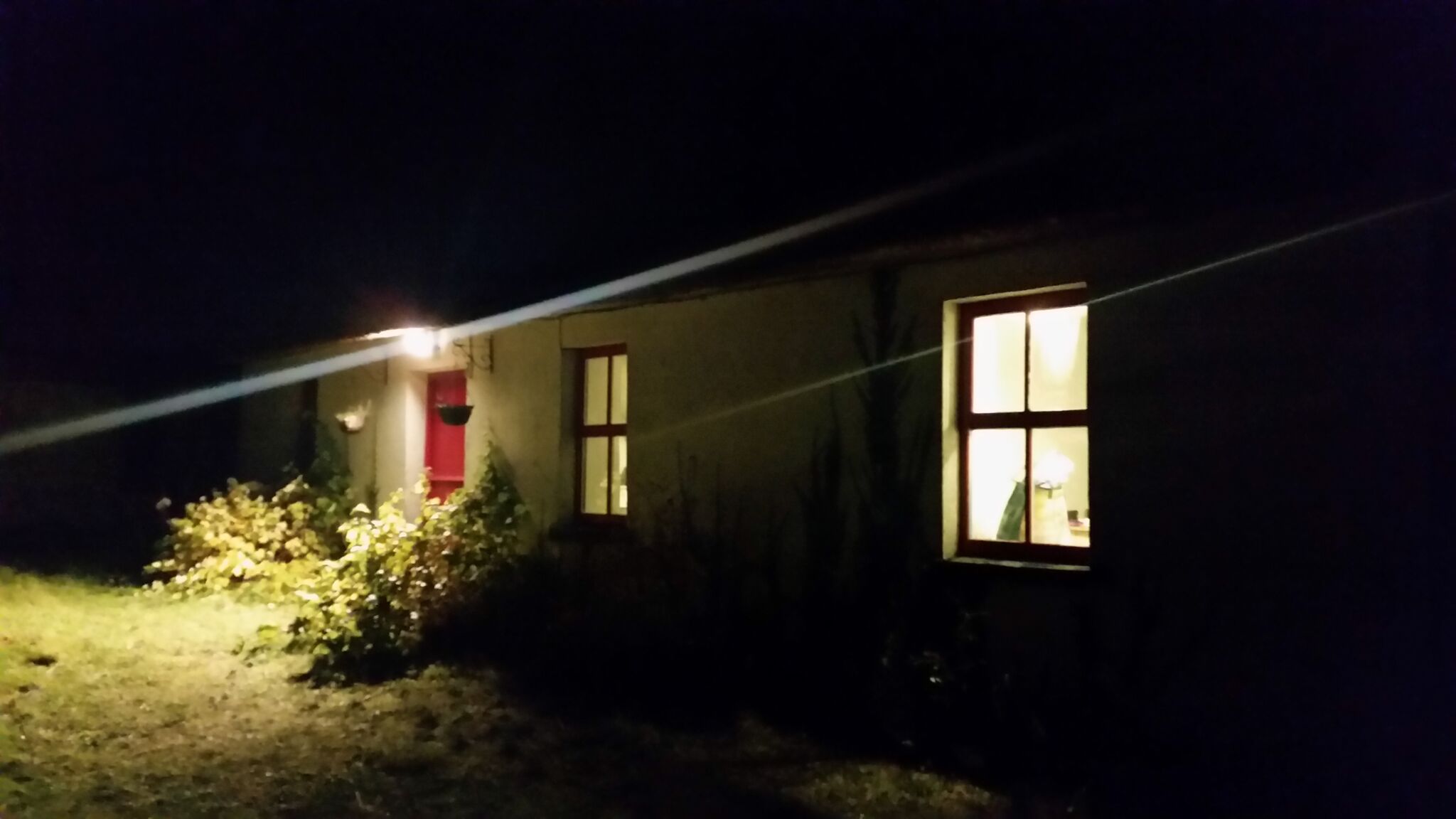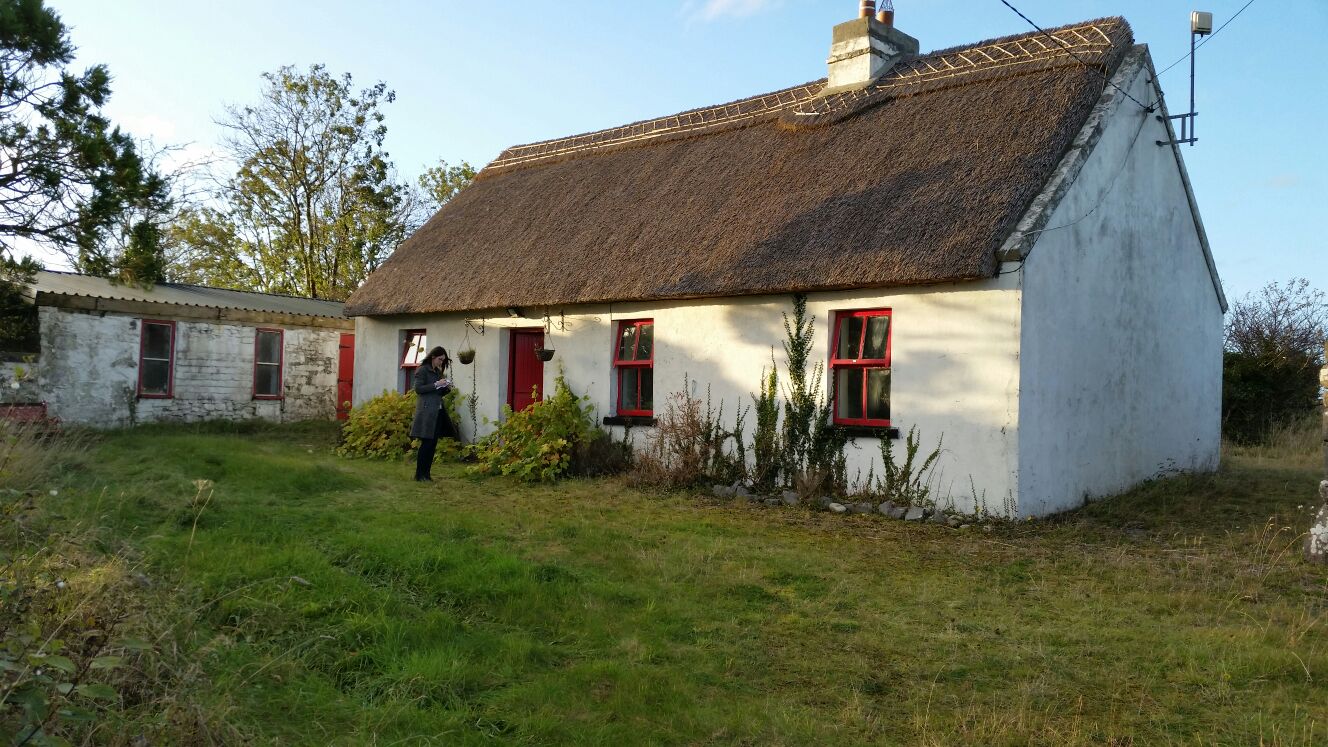Thanks to our good friend Achim for this fantastic video of the cottage.
Author: Philip
It’s been 18 months since we set about renovating our thatched cottage in Headford, Co. Galway which we have now completed.
On this site we will be writing about our experiences setting out on the project, the renovation process and our experiences owning a thatched cottage. We look forward to hearing your comments and all about your own renovation experiences.
Audrey and Philip
There were various ruins of old buildings around the cottage, all covered in thick ivy. We didn’t think much of this particular structure which we presumed was just a dilapidated old shed covered in ivy:
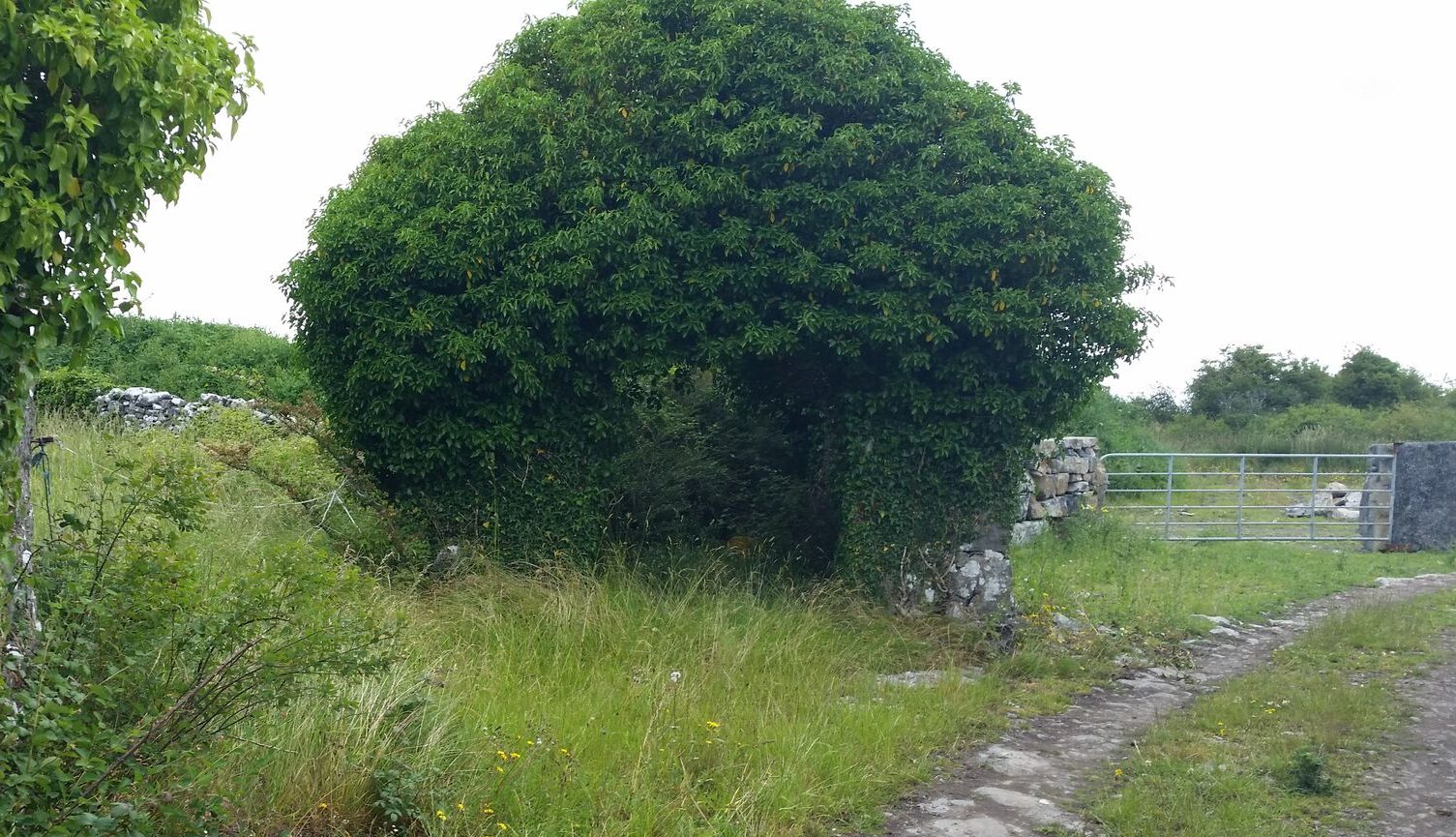 However once ivy removal started this beautiful structure started to emerge:
However once ivy removal started this beautiful structure started to emerge:
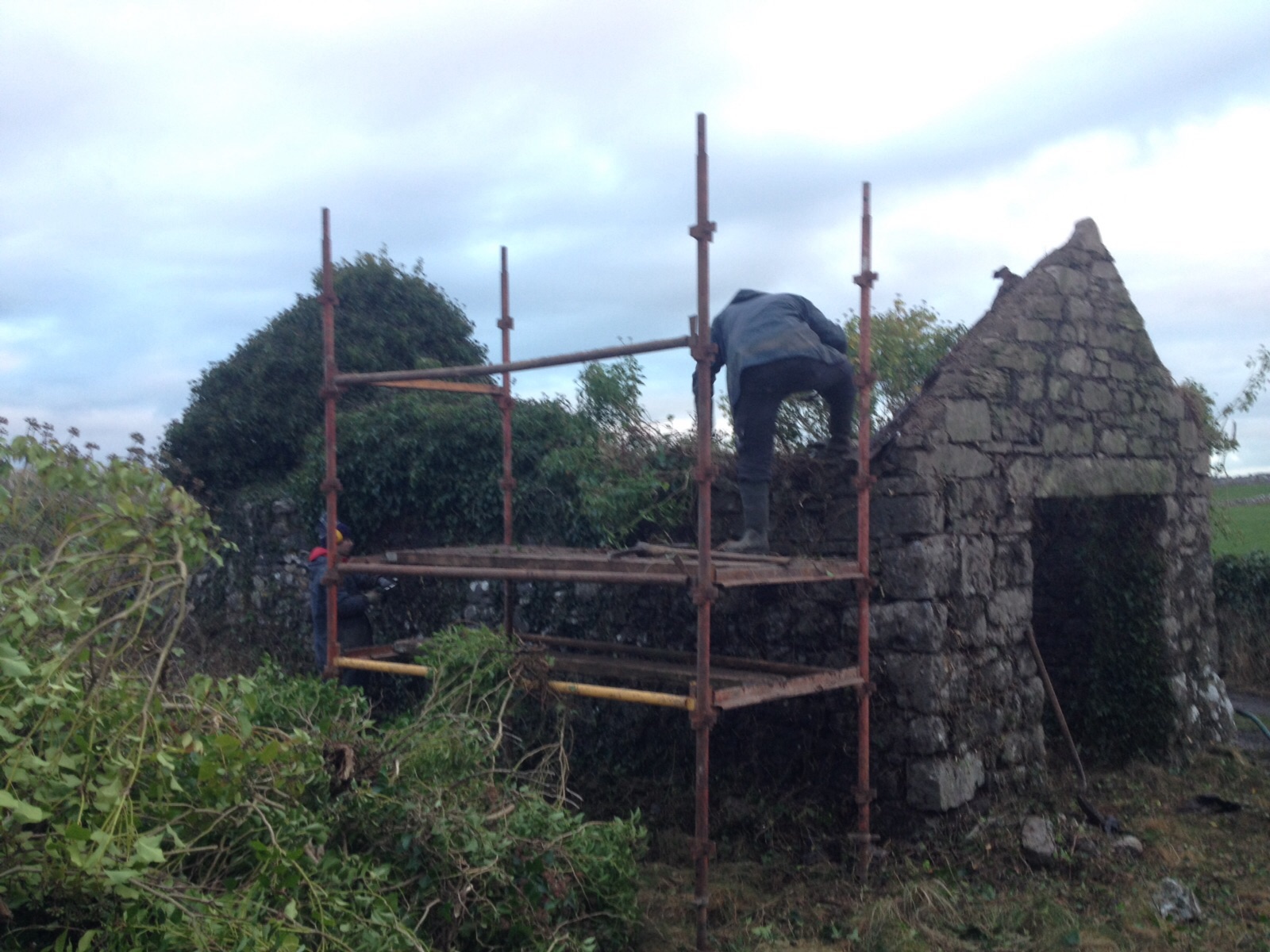 It turned out the stonework is in great condition with a limestone lintel over a wide opening (seen here below the apex):
It turned out the stonework is in great condition with a limestone lintel over a wide opening (seen here below the apex):
 We don’t have any information about the history of this structure, but one theory that this is where the family would have kept their horse and cart. The opening where the door once was leads straight onto the lane so presumably it was built in this orientation for easy access. For this reason we’ve started to call it the carriage house, a delightful surprise indeed hiding beneath the ivy!
We don’t have any information about the history of this structure, but one theory that this is where the family would have kept their horse and cart. The opening where the door once was leads straight onto the lane so presumably it was built in this orientation for easy access. For this reason we’ve started to call it the carriage house, a delightful surprise indeed hiding beneath the ivy!
As we have learned most people think owning a thatched property is a really bad idea!
A picture on a postcard? – adorable, but owning one conjures nightmares of fire, expense and collecting rain in saucepans.
In fact, the thatch has been one of the easier parts of this project. Firstly, we managed to find an expert skilled thatcher early on to guide us. This put our mind at ease on the quality of the roof, which fortunately was reasonably good and just in need of some maintenance. Secondly, we realised that the longer term economics of owning a thatch roof once understood were not that bad.
We’ve come to realise that although the thatch requires yearly maintenance and will eventually need to be replaced, this expense is nothing compared to the maintenance required on a larger property. When we were looking at houses on the Irish market we could have picked up a large 4/5 bedroomed house in the countryside for the same price. But that’s 4/5 bedrooms with each room having at least one window, door, carpet, interiors and furnishings to maintain. Then theres painting, inside and out – more surface area. More bathrooms, more fittings. More plumbing, more electrical work. Houses have roofs too – big ones! Our maths told us that longer term a thatched cottage would be cheaper to maintain simply because its smaller than most houses.
But don’t you have to replace the thatch eventually? Yes but a good thatch can last 20 or more years. You can also extend the life of your thatch by 5 to 8 years by spending about €150 a year on maintenance.
On the subject of fire, if you do the research you’ll find that most fires on thatched properties are not due to sparks landing on the thatch as you might expect. They are from badly constructed and badly insulated chimneys that allow the heat from the fire to heat the thatch causing fire. You cannot get insurance unless you can prove you have put in the correct insulation to prevent this. So in practice if you follow the guidelines the risk of fire is minimal.
So the verdict on thatch? We love it!
Before the purchase we thought checking email on our phones occasionally would be sufficient given we wanted the full remote countryside experience, but in practice the mobile phone reception was terrible.
We could only get data on our phones occasionally and it required you to stand in the cold and mud outside holding the phone in the air.
Add to that the fact that so much research was required to find tradespeople, products and cottage information, which meant proper internet access was just essential.
We were told that a previous owner went to great lengths getting a telephone line to the cottage which involved erecting telephone poles across the fields of the adjacent farm, only to find that the distance from the exchange was too far to provide any kind of decent service.
Thankfully airwire.ie came to the rescue, a wireless based service started by locals to provide Internet to remote locations. They installed an antenna on the apex of the cottage which delivers a 2mb connection for €30 a month:
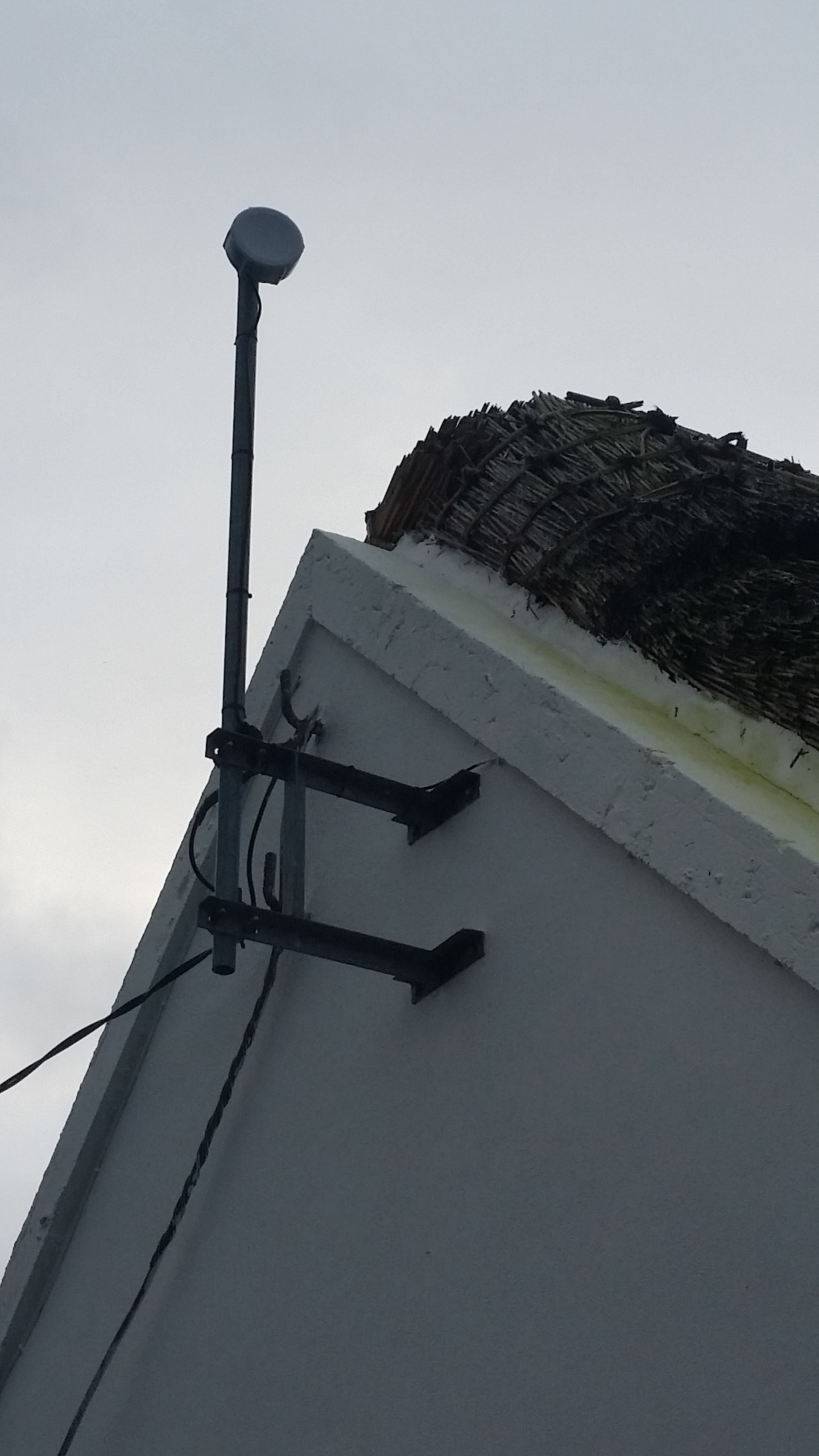
I wish all internet providers were like this. Getting internet installed in London can require weeks of waiting and 6 hour time slots with a no-show. Not airwire – “I’m only going to be around for one day, could you install my internet on Friday at 3pm?” I asked, “No problem” the friendly gentleman said, and so by 3.30pm that day we were connected.
It’s not the fastest connection (2mb) but is symmetrical which means the upload speeds are the same as download, which is rare. It works reliably and you can watch RTE, YouTube and Netflix…and yes, e-mail indoors – result!
One of the things missing from the budget was a new wood burning stove.
When we first viewed the cottage we had been very pleased to see there was a stove and it looked in reasonably good condition. However after spending a few days there in the cold of October we realised the heat output was not good enough to heat the cottage.
One reason the cottage may have had a smaller stove is that electric underfloor heating had been installed when the floor had been tiled. We had hoped to use it but found during our October trip that despite it being on for most of the stay, it barely made a difference to the room temperature and absolutely guzzled electricity! We needed a bigger stove.
We got in touch with Murphy’s of Kinvara who specialise in stoves and they confirmed based on the dimensions of the living room that we did indeed need a stove with double the current output. We needed to get this installed as soon as possible as we were hoping to spend a few days in the cottage at Christmas when the weather would be at it’s worst.
We soon discovered that there was a secondary reason to get a new stove installed, insurance. To fully insure the cottage against fire we needed to have what is called a ‘double skin stainless steel liner’ in the chimney.
The ‘liner’ part means that the top of the stove must be connected to a steel pipe that goes straight up to the chimney pot. The ‘double skin’ refers to a slightly more expensive version of a standard stainless steel liner, which has a second layer of piping running through it. This double layer reduces the probability of excess heat igniting any exposed thatch and guards against any deterioration/damage to the liner that could then leak sparks or fumes.
The chimney column also needs to be surrounded by a material called vermiculite. This comes in bags of loose fill chips which are poured in around the steel liner to further insulate and protect the flu.
We attempted to find out whether the existing stove had a double liner and had a chimney sweep out to assess. Unfortunately he wasn’t able to get access to the chimney cavity without risking debris from the chimney filling the living room. That process would have also rendered the stove unusable. So we were unable to determine what we had and therefore unable to get insured for fire.
There is no compromising or negotiating on this, in our experience you simply cannot get sufficient insurance for a thatched property unless you can prove you have a double skinned liner. But insurance aside, of course we also wanted peace of mind for ourselves that the stove was correctly installed and safe.
So we ripped out the old liner and went for a full new installation. As it turned out the existing liner had not been double skinned and there was no vermiculite in the cavity, only random pieces of building debris so the existing stove had been somewhat unsafe.
Here is the double liner being pushed down the chimney to be connected with the stove:
The grandparents also joined us on this trip to lend a hand. Here we are outside while the stove was being installed (the white bags are the vermiculite ready to be poured down the chimney).
The stove we ended up going for was the Nestor Martin Harmony I. Getting this fired up for the first time and feeling the warmth fill the cottage was a moment of great joy!
Our decision to buy this particular thatched cottage happened very quickly but it was the culmination of a much longer journey towards buying somewhere in Ireland.
We are both from Ireland but now live in London. We had always wanted to own our own home in Ireland. We were also keen to leverage Audrey’s skills as an interior designer. Audrey has her own design business in London and works with people to renovate their homes yet we had never undertaken a renovation of our own. Increasingly it felt like we needed to take action on these longer term goals.
Following the housing market crash in Ireland we were watching property prices in Ireland for a few years and finally around early 2015 we felt the timing was becoming right. The market had recovered and property prices were increasing in Dublin, yet in the countryside prices were still relatively flat with supply quite high. Also with sterling very strong against the euro it felt like a window had opened that may not appear again for a very long time.
Why a thatched cottage?! The market was swarming with large family houses and classic countryside bungalows at bargain basement prices. For the same money we could have picked up a large family home in the countryside. When we told people about the purchase, we could see they were afraid to ask us the obvious question – why don’t you get more for your money? (and you are crazy, aren’t thatch roofs a nightmare – but we’ll leave that to another post!)
I think its important here to define what ‘more for the money’ means to us. More can mean more bedrooms, more space and more land. More can mean re-sale value, proximity to town or south facing. However to us, more meant character, uniqueness and longevity. We wanted something timeless, a piece of history, something unique to the special country we had left behind. It wasn’t long before searching daft.ie that we came across the first thatched cottages, and instantly we were curious.
We first fell in love with another cottage in Spiddal, a Gaeltacht (Irish speaking) community in Connemara, not far from Galway City. We placed an offer on this but ended up a bidding war and lost. We were quite devastated, which surprised us. We really had our heart set on a thatched cottage more than we realised.
A couple of months passed and the thatch idea had far from waned, so we planned a trip back to the west. We blitzed it for 2 days viewing a wide range of properties around county Galway, finding this gem buried away near Headford. It was literally buried behind overgrowth, damp inside and in need of significant work – but we instantly knew this was the one for us.
After first seeing the cottage in July the sale finally went through at the end of October and we headed to Galway to pick up the keys.
We had only seen the cottage in the summer months and each day Galway had welcomed us with beautiful sunny skies. Despite the overgrowth and work required, the cottage always looked striking and it was that image and our belief in its further potential that kept us motivated during the purchasing process.
Now on a dark day in October as we headed to the cottage for the first time as owners, we couldn’t help contemplating what might await us both on arrival and during the months and years ahead.
With the warm summer long gone would the cottage be plagued with damp?
Did we really understand all the renovations required? Were we going to run out of money and be left with a half-completed uninhabitable cottage?
Was it a huge mistake to take on such a project with us both working full-time in London and having a 3 year old child?
As we drove down the lane to the cottage and saw it appear behind the trees our nerves were instantly calmed! We relaxed and started to enjoy the adventure.
We opened the door to find that the previous owner had cleared away much of the excess furniture and possessions, more than We expected which was great. The cottage had been vacant for a couple of years and there was a damp/musty smell in the air. We set about airing the place out and doing some basic cleaning of surfaces and floors. Then we lit the woodburning stove and dragged out a large old rug which made a huge difference. A couple of hours later it already felt much fresher inside.
Audrey and I were willing to stay in the cottage whatever the condition, but we had our 3 year old daughter to think about and needed to be sure it was clean and safe enough for her. We had a backup plan that we could stay in the Anglers Rest Hotel in Headford, but as evening approached and we started to get the place into shape, we had to stay in our new cottage, insects and all! We inflated some airbeds on the mezzanine floor and settled in for the night.
The next morning we were up early and it was time to get outdoors. We continued to clear things out and were able to have a proper look around the grounds of the cottage.
Over the next few days, we started to make a list of all the immediate things we needed to do if we were going to stay at the cottage while we started on the renovation project.We needed to get an assessment of the electrics and if at all possible we realised we would need internet access to help organise the project as we could not get data on our phones. We realised we would be very dependent on the woodburning stove but found it to be inadequate to heat the cottage. At a very minimum until we looked into getting a new bigger stove we would need to get the chimney swept for safety.
We left that weekend and went back to London both excited and daunted by the mammoth task ahead. We started by planning a trip for a few weeks later, our hope being that we could carry out some of these initial improvements before Christmas.
I remember when we bought our first place in London and were incredibly excited when the survey arrived in the post.
After the drudgery of flat hunting for months, price negotiations (I mean agreeing to pay more than we ever imagined) and convincing a bank to give us a mortgage after one of us had just been made redundant, it was time for the tide to turn. This was the good bit, that little bit of process at the end, the proof that we had indeed been clever enough to choose the most perfect property on the market at the best possible price.
Wrong of course. Our survey for that little flat threw up so many issues it delayed the sale by 6 months and in the process we learned more than we had ever planned to about leaseholds, freeholds and English property law.
Hardened from multiple experiences like this we set out to get a survey on the cottage and braced ourselves for a laundry list of bad stuff – the surveyor did not disappoint!
There were a bunch of problems. The state of the septic tank could not be determined, the sewage plumbing in the cottage was not fit for purpose and plumbing in general needed some work. There was a water leak buried somewhere under the concrete in the bathroom causing damp in that area. There were structural problems with the chimney and they were recommending that it be replaced. Also a raft of other minor issues from joinery to window repairs.
We were expecting issues like that, but what we didn’t expect was such an extreme diagnosis on the damp related issues in the cottage. The surveyor carried out a number of rising damp tests. They do this by measuring the moisture in the walls at different heights above ground. Ours showed significant moisture – the walls were very wet inside.
The reason was that the old stone walls had at some stage (perhaps in the past 50 years) been re-rendered with cement. Traditionally cottages had been finished with lime based materials which allow the absorption and evaporation of moisture more naturally. Cement, the cheaper alternative, locks in the moisture leading to rising damp.
The solution suggested was to completely re-render the whole cottage. This would involve a painstaking process of removing the cement and replacing it with lime based mortar, for all walls, both inside and outside the cottage.
This was giving us second thoughts on the purchase. We expected work, but early estimates had this adding another third or half to our budget. Thankfully our builder Tom was much more pragmatic. While he agreed that the preferred solution would be to re-render, he was willing to look at other options.
Tom suggested digging a french drain around the cottage to stop moisture entering the walls. Water had been draining off the thatch roof into the ground below, soaking back into the walls. A french drain would help divert the water away from the cottage.
We liked this plan and finally had the confidence to proceed with the purchase.
